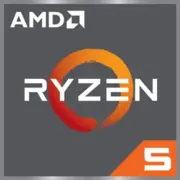AMD Ryzen 5 7645HX

AMD Ryzen 5 7645HX: A Powerful Mobile Processor for Gaming and Work
In-depth Analysis of Architecture, Performance, and Use Cases
Architecture and Process Technology: Zen 4 and 5nm Technology
The AMD Ryzen 5 7645HX processor, developed under the codename Dragon Range, is built on the Zen 4 architecture. This is AMD's first generation to transition to TSMC's 5nm FinFET process technology, which has resulted in a significant increase in performance and energy efficiency compared to previous generations (e.g., Zen 3 at 7nm).
Cores, Threads, and Cache
- 6 Cores and 12 Threads: This configuration allows for efficient task distribution among cores. For instance, during video rendering or code compilation, the load is evenly distributed, reducing completion time.
- Base and Turbo Frequency: Although exact values are not specified in the specifications, similar Zen 4 models (like the Ryzen 5 7600X for desktops) operate at a base frequency of ~3.8 GHz with a turbo boost of up to 5.1 GHz. The 7645HX is expected to maintain this trend, tailored for mobile devices.
- 32MB L3 Cache: A large amount of third-level cache accelerates data processing in games and professional applications like AutoCAD or Blender.
Integrated Graphics Radeon 610M
The integrated GPU Radeon 610M is the processor's weak point. It is based on the outdated RDNA 2 architecture but is optimized for basic tasks:
- 4K display support through HDMI 2.1.
- Capability to run less demanding games (e.g., CS:GO on low settings) or work with graphic editors like Photoshop.
For serious gaming or 3D modeling, a discrete graphics card (like the NVIDIA RTX 4050 or AMD Radeon RX 7600M) will be necessary.
Power Consumption and TDP: Balancing Power and Heat
With a TDP of 55W, the Ryzen 5 7645HX falls into the category of high-performance mobile processors. This means:
- Cooling System Requirements: The laptop must have substantial heatsinks and powerful fans. For example, ASUS ROG Zephyrus or Lenovo Legion 7 models come equipped with advanced coolers that handle peak loads effectively.
- Heat Generation in Turbo Mode: Under prolonged load (e.g., video rendering), temperatures can reach 90–95°C. However, Zen 4 automatically adjusts frequencies to avoid overheating.
In comparison, competitors in this segment — Intel Core i5-13500H (TDP 45W) and Apple M2 Pro (up to 30W) — demonstrate lower power consumption but also lesser peak performance.
Performance: From Office to Gaming
Geekbench 6: 2664 (Single-Core) / 11695 (Multi-Core)
These results place the 7645HX among desktop processors from previous years. For instance, it outperforms the Intel Core i7-11800H by 15% in multi-threaded tests.
Real Use Cases:
- Office Work: Working simultaneously with 20+ tabs in Chrome, Excel sheets, and Zoom conferences — without lags.
- Multimedia: 4K video conversion in HandBrake takes 20% less time compared to Ryzen 5 6600H (Zen 3).
- Gaming: Paired with a discrete graphics card RTX 4060 in Cyberpunk 2077 (1080p, Ultra), the processor provides stable 60+ FPS. The integrated graphics can only manage Dota 2 at medium settings (40–50 FPS).
- Turbo Mode: Under short bursts of load (e.g., launching a game), core frequencies spike sharply but may drop after 10–15 minutes due to heat.
Use Cases: Who is the 7645HX For?
1. Gamers: Ideal when paired with a powerful graphics card. Capable of handling AAA titles in Full HD.
2. Professionals: Video editing, 3D rendering, programming — multi-threading accelerates productivity.
3. Students and Creatives: Versatile for study, graphic design, and streaming.
Not Suitable For:
- Users prioritizing battery life (see below).
- Ultrabook enthusiasts — the processor requires a bulky chassis.
Battery Life: Compromise with TDP 55W
Under active load (gaming, rendering), laptops with the 7645HX will last on battery for 1.5–2 hours. In office mode (brightness at 50%, Wi-Fi) — up to 5–6 hours.
AMD Power Saving Technologies:
- Precision Boost 2: Dynamically adjusts frequencies, conserving charge during idle states.
- AMD PowerNow!: Similar to Intel SpeedStep, it lowers core voltage during background tasks.
Tip: Choose laptops with a battery of at least 80 Wh and support for USB-C Power Delivery for fast charging.
Comparison with Competitors
1. Intel Core i5-13500H (14 cores, 20 threads): Better in single-threaded tasks (e.g., Adobe Premiere) but weaker in multi-threading. TDP 45W offers slightly better battery life.
2. Apple M2 Pro (12 cores): Leader in energy efficiency (up to 10 hours of use) but limited compatibility with Windows applications.
3. AMD Ryzen 7 6800H (Zen 3+): 10–15% slower in multi-threaded tests but cheaper.
Pros and Cons
Strengths:
- High multi-threaded performance.
- Support for PCIe 5.0 and DDR5 for future upgrades.
- Modern 5nm process technology.
Weaknesses:
- Weak integrated graphics.
- High heat generation.
- Limited battery life.
Laptop Selection Recommendations
1. Gaming Models: ASUS ROG Strix, MSI Delta. Discrete graphics and at least 16GB DDR5 are essential.
2. Workstations: Lenovo ThinkPad P16, Dell Precision. Focus on cooling and displays with accurate color reproduction.
3. Versatile Laptops: HP Envy 16. Good balance between weight and performance.
Key Considerations:
- Cooling system: at least two fans and heat pipes.
- Ports: HDMI 2.1, USB4 for external monitor connectivity.
- Display: 144Hz for gaming, 100% sRGB for design work.
Final Conclusion
The AMD Ryzen 5 7645HX is an excellent choice for those seeking a powerful mobile processor for gaming, editing, or engineering tasks. Its key advantages include high multi-threaded performance and support for modern standards (DDR5, PCIe 5.0). However, its weak integrated graphics and high power consumption make it less appealing for users who value battery life or work exclusively on iGPU.
Ideal User: A gamer, video editor, or engineer willing to tolerate the weight of the laptop and the need for frequent charging in exchange for the power of Zen 4.
Basic
CPU Specifications
Memory Specifications
GPU Specifications
Miscellaneous
Benchmarks
Compared to Other CPU
Share in social media
Or Link To Us
<a href="https://cputronic.com/cpu/amd-ryzen-5-7645hx" target="_blank">AMD Ryzen 5 7645HX</a>